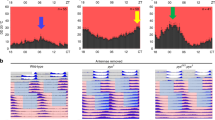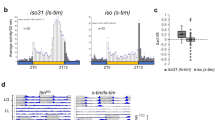Abstract
FEMALES of the parasitic wasp Nasonia vitripennis give rise to diapausing progeny (fourth instar larvae) when maintained at short daylength (< 15.25 h/24) but to continuously-developing or non-diapause progeny at long daylength (>15.25 h/24) (ref. 1). Although the precise anatomical location of this photoperiodic ‘clock’ has not been determined, it is entirely maternal since the eggs are committed for either diapause or non-diapause development before they are deposited within the host blowfly puparium: by analogy with the aphid Megoura viciae2 and the silkmoth Antheraea pernyi3, the clock and photoreceptors are probably in the brain. Photoperiodic time measurement in N. vitripennis is known to be a function of the circadian system4, and in all probability two separate circadian oscillators, one phase-set by the ‘on’ transition of the photoperiod and one by the ‘off’ transition, serve to ‘measure’ the phase-angle between ‘dawn’ and ‘dusk’5. Since, in principle, an experimentally observed action spectrum should correspond directly with the absorption spectrum of the pigment molecule involved and thereby lead to its identification, the spectral sensitivities of the ‘dawn’ and ‘dusk’ transitions of the daily photoperiod were determined for N. vitripennis.
This is a preview of subscription content, access via your institution
Access options
Subscribe to this journal
Receive 51 print issues and online access
$199.00 per year
only $3.90 per issue
Buy this article
- Purchase on Springer Link
- Instant access to full article PDF
Prices may be subject to local taxes which are calculated during checkout
Similar content being viewed by others
References
Saunders, D. S., J. Insect Physiol., 12, 569–581 (1966).
Lees, A. D., J. exp. Biol., 41, 119–133 (1964).
Williams, C. M., and Adkisson, P. L., Biol. Bull. mar. biol. Lab., Woods Hole, 127, 511–525 (1964).
Saunders, D. S., Science, 168, 601–603 (1970).
Saunders, D. S., J. Insect Physiol., 20, 77–88 (1974).
Kogure, M., J. Dep. Agric. Kyushu imp. Univ., 4, 1–93 (1933).
Dickson, R. C., Ann. ent. Soc. Am., 42, 511–537 (1949).
Geispitz, K. F., Zool. Zh., 36, 548–560 (1957).
Claret, J., C.r. hebd. séanc, Acad. Sci., Paris, 274, 1727–1730 (1972).
Williams, C. M., Adkisson, P. L. and Walcott, C., Biol. Bull. mar. biol. Lab., Woods Hole, 128, 497–507 (1965).
Müller, H. J., Zool. Jber, Neapel, 70, 411–426 (1964).
Harris, F. A., Lloyd, E. P., Lane, H. C., and Burt, E. C., J. econ. Ent., 62, 854–857 (1969).
De Wilde, J., and Bonga, H., Entomologia exp. appl., 1, 301–307 (1958).
Lees, A. D., Nature, 210, 986–989 (1966).
Norris, K. H., Howell, F., Hayes, D. K., Adler, V. E., Sullivan, W. N., and Schecter, M. S., Proc. natn. Acad. Sci. U.S.A., 63, 1120–1127 (1969).
Hayes, D. K., in Biochronometry (edit. by Menaker, M.) 392–402 (Nat. Acad. Sci., Washington, 1971).
Bradshaw, W. E., Biol. Bull. mar. biol. Lab., Woods Hole, 146, 11–19 (1974).
Pittendrigh, C. S., Eichhorn, J. H., Minis, D. H., and Bruce, V. G. Proc. natn. Acad. Sci. U.S.A., 66, 758–764 (1970).
Claret, J., C.r. hebd. séanc Acad. Sci. Paris, 276, 3163–3166 (1973).
Bruce, V. G., and Minis, D. H., Science, 163, 583–585 (1969).
Frank, K. D., and Zimmerman, W. F., Science, 163, 688–689 (1969).
Bünning, E., in Biochronometry (edit. by Menaker, M.) 203–211 (Natn. Acad. Sci., Washington, 1971).
De Wilde, J., A. Rev. Ent., 7, 1 26 (1962).
Saunders, D. S., J. exp. Biol., 42, 495–508 (1965)
Author information
Authors and Affiliations
Rights and permissions
About this article
Cite this article
SAUNDERS, D. Spectral sensitivity and intensity thresholds in Nasonia photoperiodic clock. Nature 253, 732–734 (1975). https://doi.org/10.1038/253732a0
Received:
Revised:
Published:
Issue Date:
DOI: https://doi.org/10.1038/253732a0
This article is cited by
-
Circadian entrainment to red-light Zeitgebers and action spectrum for entrainment in the jewel wasp Nasonia vitripennis
Journal of Comparative Physiology A (2023)
-
Time measurement in insect photoperiodism: external and internal coincidence
Journal of Comparative Physiology A (2023)
-
Photoperiodic time measurement, photoreception, and circadian clocks in insect photoperiodism
Applied Entomology and Zoology (2022)
-
10.1007/BF00302794
CrossRef Listing of Deleted DOIs (2011)
-
Photoperiodism and the photic environment of the pitcher-plant mosquito, Wyeomyia smithii
Oecologia (1979)
Comments
By submitting a comment you agree to abide by our Terms and Community Guidelines. If you find something abusive or that does not comply with our terms or guidelines please flag it as inappropriate.



